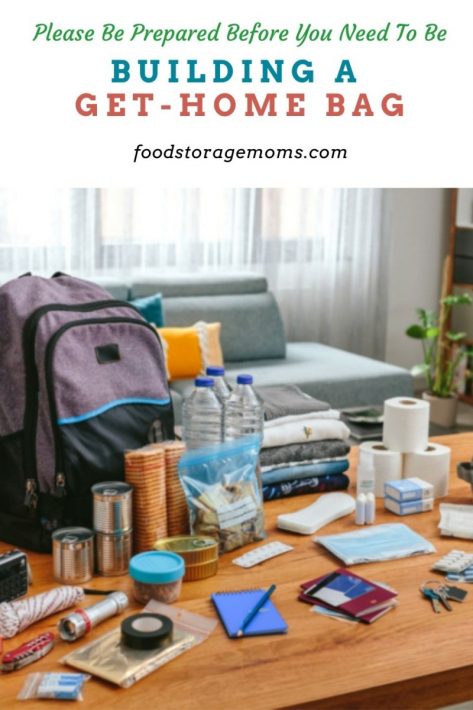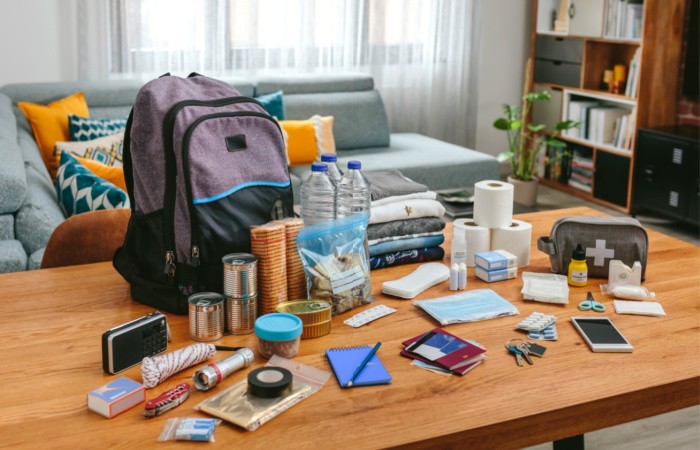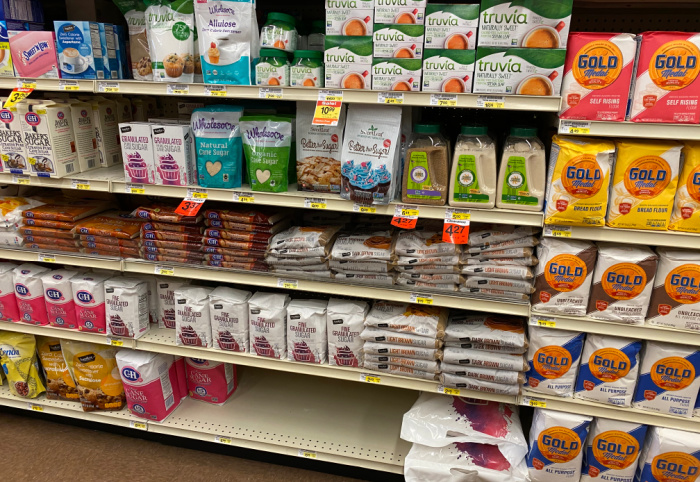Building A Get-Home Bag
Today it’s all about building a get-home bag for your family. You can decide what you think is important to put in your bag. Here’s the deal, most everyone has a bug-out bag or 72-hour kit, right? I’m updating this post today because I know several of us want to visit family and friends for the holidays and that changes things.
Hopefully, you said yes to the holiday invitation because families are what life’s all about. Well, we may be miles from our home when a disaster hits in our neighborhood. Now what?
Whether it’s out of the area for a family gathering, at work, grocery shopping, or going to a movie and the roads are blocked or shut down for some reason, we need to have several items available to help us get home. Are you prepared to walk home in your work shoes?
My flip-flops would not cut it, I can tell you that right now. In case you missed this post, Mommy’s Get Home Bag or What You Need in a Stay At Home Bag
Building A Get-Home Bag

Get-Home Bag
If you have a get-home bag or survival kit on your person or in your car you can hopefully walk home, or at least have the essentials you need if you have to stay in place if you are directed to. You may be thinking, “Is it okay to leave this bag in my car?”
Let’s talk about this. This bag will be smaller than your 72-hour bug-out bag, but you still may not want to drag it into the office every day if you park the car in a large lot and walk into your work building. Here is my 72-hour Kit article complete with printables.
I would make sure you have another bag in your office filled with things you can put in a large drawer, closet, or cupboard in case you must stay within your office area for an extended period of time if a disaster hits during work hours.
Office Emergency Bag
Hopefully, this will never happen, but just in case, I would stock a few items in your office like the following list below. Please rotate food and water as needed.
- Flashlight: either with or without batteries. Small Olight Flashlights or Larger Olight Flashlights
- All-purpose tool: my son-in-law carries a tool with all sorts of “attachments” that comes in handy for him so often.
- Snacks: like protein bars, trail mix, or jerky
- Water: I highly recommend a case of Blue Cans (cheapest place to buy them is on this website: Brownells Website
- First Aid Kit: (this would have fewer items than your car first aid kit) You may want Bandaid strips, Neosporin, Blood Clotting solution, Benadryl, fever reducers, etc.
- Heavy gloves: to use for tasks of all kinds.
- Knife: you can always use a knife in case of an emergency, and to protect yourself.
- Headlamp with extra batteries: you can always use some headlamps in case the power goes out unexpectedly and there are zero windows in your office or it’s dark inside and outside.
- Paracord: it’s nice to have a few different lengths of paracord because it can be used for so many purposes in emergencies.
- Cash (small bills): you will need these in case the ATM’s don’t work because of a power outage.
- Contact Information: Contact List
- Rain Poncho: no one wants to be cold and wet. Also, possible change of clothes if they get wet, soiled or otherwise uncomfortable.
- Small Blanket: if the power is out, the heating system won’t be working. Plan ahead for help staying warm.
Get Home Bag Items
Some of these will be duplicates from the office bag, just giving you the heads up. The 72-hour kits are for about 3 days or so, as we’ve all been told to prepare for. These get-home bags are just that, it has enough stuff to get you home.
- Contact List: this is one I designed for my readers: Contact List
- Toilet Paper: you know when nature calls so you may as well be ready. You can use TP for your nose or private parts.
- First Aid Kit: please stock small packets of Neosporin, Bandaids, fever reducer, Benadryl, and whatever you can fit in your bag that may be particularly inportant to you.
- Hand Sanitizer: it helps to cut down on germs, no matter what the source. We never know who or what we may have to touch, carry, or otherwise deal with in emergency situations.
- Cash: small bills just in case the power is out for an extended period and the ATMs, bank drive windows, or other sources for cash don’t work.
- Flashlights: either with or without batteries. Small Olight Flashlights or Larger Olight Flashlights
- Water container with a purifier: my favorite one is the Sports Berkey Bottle or the LifeStraw
- Food/snacks: like protein bars, trail mix, crackers, energy bars, and other items we all like in a pinch.
- Binoculars: you may need to see in the distance what is or has caused the problems you’re dealing with, and thus, determine how long you’ll be in the current situation.
- Paracord: cut some strips and tie them to your bag to use when needed.
- Headlamps and batteries: flashlights are great, but if you have to carry items then a headlamp really comes in handy.
- Sunscreen and lip balm: who knows if you’ll be outside when things turn ugly. We may not have the safety and cover provided by an office.
- Bug Spray: again, you may be outside when trouble comes.
- Wool socks/boots or comfortable shoes: you may have to hike or walk farther than you expect.
- N95 or N100 masks: we never know if we will be in the middle of a pandemic or an unforeseen disaster where germs become an issue. These would help with widespread diseases or smoke inhalation.
- Hatchet: you never know when you may need one of these particularly if your work building is damaged.
- Bandannas and rain ponchos: I wrote a post about the many uses of Bandannas, check it out in my archive. The rain ponchos can help keep you dry, shield you from heavy winds, and possibly act as a lean-to.
- Duct Tape: you can use duct tape for so many things, the list seems endless.
- Matches: if outside and cold then you may want to start a fire for warmth or to attract attention from others coming to help.
- Hat: a waterproof one will serve two purposes, sunshine, and rain.
- Garbage bags: for ground cover or use as a poncho/baggies.
- Compass or GPS: this is great to help you get your bearings to determine where you are at any given time.
- Zip Ties: here are some ways you can use Zip Ties
- Whistle: may need it to get other’s attention, particularly if the building has collapsed around you. Here is a great Whistle
- Medications: Thank you, Matt: put a few days worth of medications in yo ur bag, you don’t know when you will get home.
- Sillcock Keys: This is a Sillcock Key that we all need. Thanks to DMWalsh, for those unaware of them, sillcock keys are used to open “tamper-resistant” water faucets that are found on the outside of almost every commercial building. Paul, this allows you to access the hose bib on most any commercial building.
What is a Get-Home Bag?
It’s a bag to help you get home in case of an emergency wherever you may be at the time.
Why do I need a Get-Home Bag?
It’s a bag that will have the things you decide beforehand you may need in case you are stranded at the grocery store parking lot, on the freeway, or even at church. It will be in YOUR car when YOU need it.
Is it a smaller bag compared to a 72-hour kit?
Yes, it is smaller because the 72-hour kit or bug-out bag is for 72-96 hours. You can use it at a church or school building when you have to be evacuated, for instance.
Can my child carry it?
Absolutely, unless you decided on an oversize bag that is bigger than the child. It’s a backpack filled with items you hand-picked for you and your family’s needs.
Plan a Trial Run-Practice-Practice-Practice
It’s always nice to do a trial run or practice using it before you need it. You will very quickly learn what you need or forgot to put in your bag.
MAPS
Thank you, Matt
Final Word
I hope you put together a get-home bag for you and your family members. Life is good if we are prepared before we need to be ready. You should also check out My Emergency Car Kit. It will prove so helpful if you are on a trip and the car breaks down, the road are closed, or you need to help out other motorists in trouble. Thanks for being prepared for the unexpected. May God bless this world, Linda
Copyright Images: Depositphotos_107903872_m-2015, Emergency Bag Depositphotos_377504588_s-2019, Emergency Bag AdobeStock_442859322 by David Pereiras






















I preach the flip flops everyday to deaf ears.
I’ve got 2 levels of weapons. I always carry a handgun which round here is normal and accepted in society. Hopefully I’m moving during this time. If so my AR “pistol” will be in my bag and if things have decayed it will be in my hands. I won’t start with it in my hands as it could create more issues at the start of a crisis than it’s worth.
The GMHB might not be smaller than a 72hr bag. It probably shouldn’t be. Around here it’s nothing to drive 40 minutes to an hour to shop, eat or do things. Even the range I shoot competition at is 42 miles away. My job is 21 miles away and for good reason.
What I’m getting at is that walk might be 2-3 days. I hike regularly and have military experience where I carried my house on my back. Many don’t and will struggle with 8-10 miles a day much less 20. If you get off the roads and cross country it takes longer. Hills or mountains cross country and 6-8 miles a day while keeping your head on a swivel is about normal.
I discovered that some main power lines run from near my job to home so that’s my off road route. Make sure you download maps of areas you work, shop, play to home.
https://www.natgeomaps.com/trail-maps/pdf-quads
https://expeditionportal.com/national-geographic-now-offering-usgs-maps-for-free/
Hi Matt, I LOVE your comment! I’m going to add those maps to my post, thank you so much for those links! My GHB is bigger than my EDC, I’m with you it may take 2-3 days to get home. You are in shape, me not so much! I LOVE your comment, it should inspire ALL of us to get walking to make our bodies strong! THANK YOU! Great comment as usual! Linda
I get what you are talking about as far as miles go: I’m in rural MN, live 7 miles from nearest convenience gas stop, 15 miles minimum to nearest towns in any direction. I travel (often overnight) quite a ways from home so if something happened, yes, it would take me awhile to get home. I have a 20 yr old son and 18 yr old grandson who I insist keep an emergency bag in their vehicles. My son has added 2 more blankets in his car: he works about 30 miles from home. My grandson is at that age where he doesn’t want to listen, thinks he can easily walk home as he only works 12 miles from home. (Funnily enough, both of these guys used to walk to town or skate board/bike, so yea, they could do the walk easily, except in winter!) Um, my grandson crashed my van this winter. He and his 2 passengers were practically frozen by the time we were able to pick them up, get van towed. He totally forgot that there were 3 blankets in large Ziplocs in the back end of van. Man, it is hard to prep teens.
You stay positive on what you teach them kids. I’m shocked at times but proud when my children do things I taught them. My son saved a guy in a wreck with a tourniquet that I didn’t even know he had made into his EDC. It was a shiny moment for the crazy ole dad.
I can’t wait till the grands are old enough to start teaching.
Hi Matt, I LOVE your comment! When your grands are old enough they will learn so much from you!! Linda
A VERY LOVELY SUNDAY MORNING FROM SEATTLE! I have to say I loved it very much IT hard for me to do because I am 75 and 100% disable I read and pass it on to my friends and family again THANK YOU
Hi Sarah, good morning from Utah! Thank you for passing my articles along, you will be blessed! Stay home and stay well! Hugs, Linda
The wife and I are very different physically. I put the best bag together that she can carry. She has lupus and her hands don’t always work the best so the firesteel is the large gobspark, full size lighter and the p38 type can open has a spoon on the end for leverage. Other than that it’s scaled down from mine.
Make sure it’s tailored to you no matter the “experts” and it can grow and shrink with weather conditions.
Also medication is needed. I keep a few days worth in it. Don’t worry about cholesterol meds and such but gerd, blood pressure etc needs to be in there.
HI Matt, thanks for the reminder on medications! I’m adding that to the list! THANK YOU!! Linda
I am disabled, but I have a bugout bag which is useless to me, but maybe I can barter it for a ride or other assistance if things go wrong.
Hi Roxanne, great comment! We have to think about stuff like this! We will all be bartering! Linda
If “the big one” hits while I’m at work, I will be completely shut off (as will thousands of other people) from getting home as the Columbia River separates me from my sweetie. I started out thinking I needed to be prepared to get home but I’ve had a paradigm shift. Getting home is our first instinct but maybe staying put would be a safer option. How to stay put for possibly weeks? That thought put me on a different path. I don’t have others dependent on me so that made thinking differently a bit easier but I would want a way to let those I love know I am safe. If I was stuck at work, there would be two or three others in my position so I made it my job to talk to those folks so they wouldn’t be dependent on me and my supplies. Thinking about preparations from a new angle was enlightening. I carry potentially 44 meals in my car (variety of freeze dried, dehydrated, MRE’s, and pouched foods), a hand-held ham radio (tested so that I know I can reach local repeaters to reach my sweetie), paper maps, water, fire, season appropriate warmth, shoes – well, you get the idea. I’ve identified what may be the most survivable accessible room at work where employees can hunker down and made a sanitation plan. Yes, I carry my car kit with me at all times and it takes surprisingly little space. I urge folks to identify people who might be helpers to those you love in case you can’t get home and give yourself some peace of mind by thinking a bit differently, if your best (or only option) is to stay where you are instead of frantically want to immediately get home along with who knows how many other people.
Hi Debbie, great comment! I love hearing you have talked to co-workers about being prepared. I work from home (my blog) but I do worry about my husband who does a lot of civic and church work several miles from our home. You are so wise to plan ahead, that’s what a great prepper does! Kudos to you my friend! Keep up the good work! Linda
I think it’s smart you’ve looked real hard at your workplace as a place to stay in an emergency, rather than rushing to try to get home. I’ve never heard or read of anyone else who has done this.
Nice article and it’s refreshing to see that all the comments are positive and that people are thinking for themselves and creating truly personalized bug out bags. Surviving and being healthy is all that matters.
Although, I’m rarely more than 3-5 miles from home, I still have some supplies in the car, a knife and flashlight in my pockets, a waist pack (Fanny pack if you prefer) and soon plan to put together an everyday carry bag.
The E.D.C. bag (Shoulder bag for me) would allow me to have the larger extras such as a water bottle, cup, Esbit pocket stove, the above mentioned and highly appreciate toilet paper, duct tape, batteries, cell phone chargers, radio, clothing items and shelter kit. Basically the all the items (you listed) that can’t fit in a pocket and make a bag necessary. And yet a shoulder bag or small backpack it won’t raise any eyebrows around town because it’s so common here.
Having multiple size kits to fit different scenarios seems the best way to be ready.
Hi Frank, it is nice to have positive comments, I delete any negative comments I do not want my readers to see. We have enough negativity on social media. Life is good when we can learn from one another and share ideas so we are ALL prepared for the unexpected. Life is good! Linda
One thing I will say about maps and compasses – Know how to use them. AND, plan out routes once you do know how to use them. Neither will do you much good if you don’t learn how to effectively use them.
For example: I have local maps and have made a survey of the main roads, overpasses, and back roads so that I know how to get where I want to go without having to deal with destroyed overpasses and heavy traffic.
I agree with those who say that you may want to stay in place. Our natural tendency is to want to get back to the most familiar place (most likely where we have the bulk of our preps) but with everyone wanting to go at the same time, it may be better to wait at least a few days before leaving your workplace.
Hi Leanne, I totally agree. My biggest concern is not being able to get ahold of my husband. We have a Plan A, Plan B, Plan C. Have you read Lights Out by Ted Koppel? Our power grid is so antiqued!! God bless this world. Hugs, Linda
Yes, Linda, I have read Lights Out. I agree that our power grid is so old. But as Ted Koppel said (and I am not quoting here just so you know) it would only take a minor computer hack to wipe out our system at least in general locations. I am not sure why this has not happened yet! Scary to think that we are so vulnerable.
Hi Leanne, I wish everyone would read that book. It’s real and not fictional. I can’t believe we haven’t been hacked yet. It will be sooner than later. Keep prepping, stay safe, stay well. Linda
I think what most people don’t seem to realize how easily this hack can be done. My rural co-op electric company has spent mega bucks to put our lines underground so aren’t affected by ice,etc. But every single line has been and is vulnerable to a computer glitch: as in, if one line has an issue, their computers can identify the exact location of problem. Sounds great, and it is, as we have fewer problems now, but this interconnectedness also leaves our entire grid vulnerable to hacking. My co-op sells electricity to many grids that serve our state’s biggest metro area: Mpls/stpaul. I think one hack would have a cascading effect.
Hi Wendy, you are so right, it would have a cascading effect! Linda
Great list! I wish I could find more sample size packets of Neosporin, Benadryl, sunscreen, poison ivy etc, bug off cremes. Then it’d be easier to carry in a Ziploc in my purse. While I always have a pretty well-stocked backpack in my car, my purse is like a mini-emergency kit. My sis recently gave me a pretty good bag I use for my make-up, travel size stuff. The bag is actually a computer/business bag. Has a compartment on bottom that fits a laptop. Has side pockets on outside of bag. Zipper close top. The reason I mention this bag is that it’s very lightweight but sturdy canvas, waterproof. Sometimes the very bags we need to hold ‘get home’ stuff weigh a couple pounds or more. I travel a lot for my job and dont want to have to carry heavy baggage into hotels. And then back to car, lol! I keep my supplies in separate small bags in this bigger bag: like, one has individual packets of meds like antacid, allergy pills, aspirin, potassium chloride drink packets, (I need this as I’m on water pills), Band-Aids,etc. Another baggie has travel size soap, shampoo, lotion, makeup remover, toothpaste and toothbrush, Listerine. I even roll up my undies and socks, putting them in Ziplocs too. I have a 7 day med plastic container that’s also small. The only heavy thing in bag is the one bottle of water. ( I have had the same bottle unopened for about a year.) There’s enough room in the bag I could transfer essentials from my purse to this. Thing is, is that while I have my backpack, it would be easier to get things from this bag when walking. I do think people really need to try a nice long walk while carrying their get home bag(s).
Hi Wendy, I’m with you on the smaller packages!! I wish I could find some that have a longer shelf-life. Linda
Linda I keep a good size duffel bag in my SUV as my “Get Home Bag”. It’s also partially a bug out bug. I could have 4 people with me so it has multiple blankets, old jackets, water, etc. which make it big & heavy. I also have a small backpack in it so if I had to leave the car I could put essentials from it in the backpack and leave the duffel bag. I have an adult son who won’t wear a coat until temps get in the teens (he doesn’t feel the cold) so I feel better knowing I have something for him if needed. Many supplies that need to be handy are throughout the car like sunscreen, hand sanitizer, can opener, small flashlight, tire gauge, maps, pain meds, napkins, etc. Oh and extra catsup packets that might be needed – important to have those for French Fries! LOL It’s great knowing those supplies are with me!
Hi Kay, oh, the ketchup is critical!! Now, I want some French fries !! I love hearing this! Some of my grandsons never wear a coat even when it snows!! LOL! You are so prepared, I love hearing this! It’s actually a really good example to others if you have to use those items! You go, girl! Linda
Here in AZ, duct tape turns into a yucky gooey mess, so we rely on paracord, mule tape, etc. If we need sticky stuph, clear packaging tape or blue painter’s tape works for a while, but AZ isn’t friendly to most kinds of tape.
For little items, like meds, consider vacuum-sealing them with your FoodSaver in whatever dosage you need. Make a label to go inside (if using transparent bags) with acid-free paper & pencil (ink could contaminate the meds).
If you seal in an aluminized mylar bag, you can label the outside with a Sharpie IF you rough-up the bag with sandpaper or ScotchBrite (don’t damage the aluminum layer) or use transparent tape over the label. Shouldn’t use Sharpie on non-aluminized bags since it’s possible for some of the solvent to permeate.
Consider putting 2 strike-anywhere matches & a strip of wet-or-dry sandpaper (rough side away from the matches) inside a section of plastic straw & heat-sealing both ends. Carrying several of these match kits might be smart.
Now, if I could just find some freeze-dried water…
Oh, yes, & notch the vacuum-sealed bags with a nail clipper or whatever so you don’t have to fight your way into them.
Maybe I should just go with dehydrated instant water…
Hi Bev & Gary, oh the freeze-dried water!! LOL! Great tip on the heat and duct tape! Great tips for all of us, thank you!!! Linda
One thing I didn’t see listed was a 4 way sillcock key. This allows you to access the hose bib on most any commercial building.
Hi Paul, thank you for reminding me about this, I need to add it to the post! Linda
My GHBs also include sillcock keys in case we’re walking past commercial buildings and we need to top off our water supplies. For those unaware of them, sillcock keys are used to open “tamper-resistant” water faucets that are found on the outside of almost every commercial building.
Thanks for revisiting these articles as times keep on getting more unsettled and it’s hard to know what we’ll suddenly find ourselves in the middle of these days. Appreciate all your work Linda!
Hi DMWalsh, I will add this to my post, thank you, my friend, I’m nervous about what’s going on everywhere. Thank you for your kind words, Linda